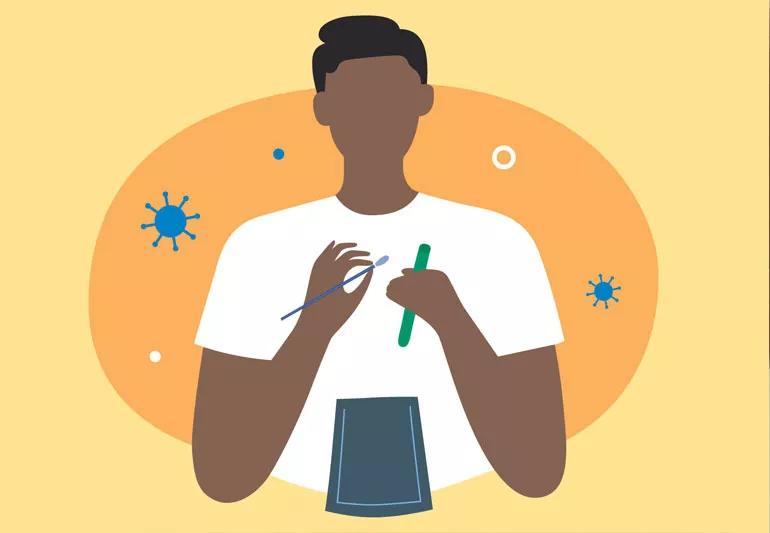Above all, follow the package’s step-by-step instructions

If you’re feeling a tickle in your throat or a twinge of a cough, it’s easy to become concerned that you might’ve caught COVID-19. In addition to staying away from friends and family, just in case, another way you can get peace of mind is by taking an at-home COVID-19 test.
Advertisement
Cleveland Clinic is a non-profit academic medical center. Advertising on our site helps support our mission. We do not endorse non-Cleveland Clinic products or services. Policy
There are multiple options available, though, which can be confusing. But read on as microbiologist and pathologist Daniel Rhoads, MD, explains how to choose and take an at-home COVID-19 test.
There are two main types of at-home tests approved under Emergency Use Authorization (EUA) by the U.S. Food and Drug Administration (FDA).
The most common is an antigen test, which detects whether you have specific proteins (or antigens) associated with the SARS-COV-2 virus. Molecular tests, which can identify genetic material, are also available.
A common COVID-19 test you would get via your healthcare provider, the polymerase chain reaction (PCR) lab test, is also a molecular test. The PCR test also identifies whether you have genetic material associated with the SARS-COV-2 virus.
Because there are different choices available, Dr. Rhoads suggests first determining what you hope to achieve by taking a test. “I always encourage everybody to start with a goal,” he says. “Is your goal to screen? Is it to diagnose? If there are symptoms, and you’re trying to confirm that you have an infection, no matter what test you use, how are you going to interpret it?”
The results of at-home antigen tests are considered accurate, although PCR tests are generally more sensitive to the virus’s presence in your body. But the accuracy of at-home tests does depend on a few factors. These include whether you obtained your sample correctly and when you tested. For example, if you test soon after being infected, you might not get a positive result right away.
Advertisement
“The take-home message is if you get a positive result, it’s probably a true positive,” says Dr. Rhoads. “The caveat is these antigen tests are not as sensitive as a PCR test. So, if you’re feeling sick, and the test is negative, that doesn’t mean that you don’t have COVID.”
Dr. Rhoads recommends following the U.S. Centers for Disease Control and Prevention (CDC) guidance on how to interpret an antigen test result if you’re not sure what’s best.
If you’re taking an at-home COVID-19 test for the first time, it’s normal to feel anxious or scared. Plus, it doesn’t necessarily feel good to insert a swab in your nose to collect a mucus sample.
The best guidance for all of these tests is to “follow the package insert” for the individual test you’re taking, says Dr. Rhoads. Every at-home test has slightly different directions and works in a different way.
For example, some at-home tests recommend what’s called serial testing, or more than one test over the course of a period of time. “Some of them say to take one test now, and then the second test so many hours or days later,” explains Dr. Rhoads. “The FDA likely included that because it recognizes that these aren’t as sensitive as PCR tests.”
Although at-home tests offer step-by-step instructions on how to take them, you might worry about following directions properly. Luckily, there are resources available for you. If you bought the test at a drugstore, you could ask the pharmacist for help. Your healthcare provider can also give you tips.
Videos created specifically by the test manufacturer are good resources, too. For example, the Ellume COVID-19 home test has an app that can walk you through the testing process. Just make sure not to watch a video for one test and assume it fits all tests. “If the manufacturer has a video, follow that,” Dr. Rhoads instructs. “You don’t want to use a test by one manufacturer and watch a different video. That’s just going to create confusion.”
In general, many COVID-19 tests have you swab your nose to obtain a body fluid sample for testing. But you may have read news articles recommending that you swab your throat before your nose when doing an at-home test.
One reason this came up is a non-peer-reviewed study found that the omicron strain of COVID-19 may cause more of the virus to appear in your bronchus, the pathway that helps get air into your lungs. As a result, people figured a throat swab might reveal you have COVID-19 sooner. But that study is still under review and shouldn’t be considered actual guidance.
Advertisement
Additionally, some of the U.K.’s at-home rapid tests also instruct that you should swab your throat and nose as part of the process. Unfortunately, this isn’t the case with the COVID-19 rapid tests currently approved under the U.S. FDA’s EUA.
“You’re not going to be able to do a throat swab because the FDA hasn’t authorized any of the tests for that method,” Dr. Rhoads says. “That’s not how the FDA evaluated their performance. And that’s not their intended use.”
He adds that more research is needed before a throat swab might be used with at-home COVID-19 tests. “Somebody has to do the study,” he continues. “You’re not sure what the performance is right now, without that. You could have false positives. The test could actually not be as sensitive.”
The FDA agrees, and has explicitly stated, “We don’t have any data yet suggesting throat swabs are an accurate or appropriate method for at-home tests.”
But there is one place where a throat swab can be used to determine whether you have COVID-19: Your doctor’s office.
“Some of the tests that we do in the lab are authorized for throat swabs,” Dr. Rhoads says. “We validated it. Companies validated it. There are methods that have been validated for throat swabs. But I don’t know of any over-the-counter tests that can be performed at home with that as a specimen type.”
Advertisement
If you do test positive for COVID-19, it can be also confusing to know what to do next. Isolating from other people in your household so you don’t get them sick is a good first step. You should also reach out to all the people you were around recently so they’re aware and test (or quarantine) if needed.
However, your first inclination might be to test again, either with another at-home test or by scheduling a PCR test, just to be sure the results are correct. Dr. Rhoads says there’s nothing wrong with doing that, although it’s not required. “If you get a positive test, you can go and get a confirmation test,” he says. “But I don’t think you need to retest. That’s not necessary.”
But at the very least, Dr. Rhoads stresses that you should document that you did test positive. Some cities or states have places where you can self-report a positive diagnosis to public health departments. Certain kinds of at-home tests also have an app that connects to your health records. You can document the results yourself with your cell phone, too.
“Take a photo of the test result if it’s positive so it can be shared electronically if you do need healthcare in the future,” Dr. Rhoads advises. “Sometimes, outpatient prescriptions can be based on whether or not you’ve tested positive. It’s helpful to the person who wants to prescribe you medicine to see that with their own eyes and confirm it. And an antigen test, I believe, is going to be an adequate way to document that you have COVID.”
Advertisement
Above all, notify your healthcare provider and stay in contact with them. For instance, Cleveland Clinic’s MyChart allows you to upload documents, so you could upload a photo of your positive at-home test. Especially if you start feeling worse or are unclear if your test result was correct, your doctor can be a great resource and help you take the best next steps to get back on the path to health.
Learn more about our editorial process.
Advertisement

This at-home test for COVID-19 and flu can help you figure out what’s causing your symptoms, and how best to treat them

Covering your mouth when you cough and staying home when you’re sick are a couple ways to help keep yourself and others COVID-free

The virus often clears up on its own within two years, but it can also linger and can cause further complications

We don’t fully understand how cleanliness impacts immune system development, but we do know that preventing illness is important

This vital nutrient supports your health, but its role in COVID-19 prevention and treatment isn’t proven

Twice daily tick checks, the right bug sprays and long pants can help you prevent tick-borne diseases

If you have a weakened immune system, your risk for getting shingles a second or third time increases

Tetanus is easy to prevent but tough to treat — vaccines are your best defense

If you’re feeling short of breath, sleep can be tough — propping yourself up or sleeping on your side may help

If you fear the unknown or find yourself needing reassurance often, you may identify with this attachment style

If you’re looking to boost your gut health, it’s better to get fiber from whole foods